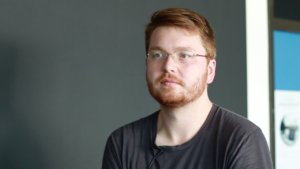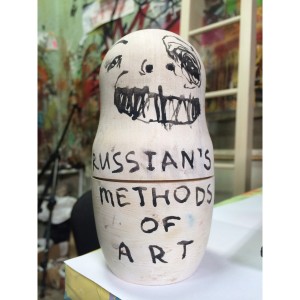What is art? That is of course an unfeasible question, but that’s the reason why it’s a justified and an interesting question. Just yesterday we discussed this with students of mine in the introductory course of Intermedia and we tried to develop a definition. And what we have developed as a definition or an attempt is: Art happens, when somebody forms any material to a conscious statement. So: Art happens. It has to be made, whatever. In a form of action or transmission. If somebody, this is generally a human being, it’s a group, it’s an authorship. There has to be an originator. So, art happens, when somebody forms any material (…). Material can be anything. Material can be physical. It can be something not artificial, it can be a thought. So (…), when any material is formed into a conscious statement (…). So it has to have an intention, an aim in the widest sense. It has to be volitional. It cannot be a coincidence. And a conscious statement is, when it’s a settlement. It can be physical or it can be ephemeral. And the formation shows, that it’s a cultural product in the widest sense. For now, I would keep this as an art definition. For me, too.
And I think personally, that art should not have any purpose, and that it should be autonomous. That it serves as a medium to maintain intellectual freedom and triggers communication. And this can be aesthetic experiences, this can be art works – it can receive a body. But it doesn’t have to. It can be any form of perception.
Was Kunst ist, das ist natürlich eine unmögliche Frage aber genau deswegen eine berechtigte und eine interessante Frage. Gerade gestern mit meinen Studenten in der Einführungsvorlesung von Intermedia haben wir über genau das diskutiert und versucht eine Arbeitsdefinition zu entwickeln. Und das, was wir dann am Schluss als Arbeitsdefinition oder Versuch entwickelt haben heißt: Kunst geschieht, wenn jemand irgendwelches Material zu einem bewussten Statement formt (Johannes M. Hedinger 2013). Also: Kunst geschieht. Es muss gemacht werden, wie auch immer. Eine Form von Aktion oder Sendung. Wenn jemand, das ist dann ein Mensch in der Regel, also es ist eine Gruppe, es ist eine Autorenschaft. Es muss irgendeinen Absender geben. Also „Kunst geschieht, wenn jemand irgendwelches Material […]“ (ebd.). Material kann auch alles sein. Also Material kann physisch sein. Es kann etwas Außerkünstisches sein, es kann etwas Ephemeres sein, es kann ein Gedanke sein. Also „wenn irgendwelches Material zu einem bewussten Statement geformt wird“ (ebd.). Also muss eine Intention haben, ein Ziel im weitesten Sinn. Es muss gewollt sein. Es kann kein Zufall sein. Und „ein bewusstes Statement“ (ebd.) ist, dass es eine Setzung ist. Das kann physisch sein, das kann aber auch ein ephemeres Werk sein. Und die „Formung“ (ebd.) zeigt noch mal, dass es ein Kulturprodukt im weitesten Sinn ist. Für heute würde ich das jetzt als Kunstdefinition mal stehen lassen. Für mich auch. Und ich persönlich finde, dass Kunst per se zweckfrei sein soll, dass es autonom sein soll, dass es dazu dient die Aufrechterhaltung der geistigen Freiheit und Mittel zur Kommunikation sein soll. Und das können ästhetische Erfahrungen sein, das können Kunstwerke sein, Körperlichkeiten bekommen. Aber es muss nicht. Es kann auch eine Form von Erkenntnis sein.

















